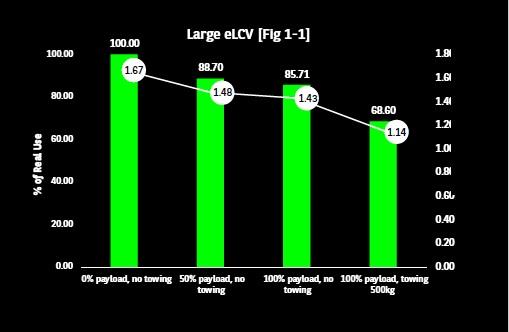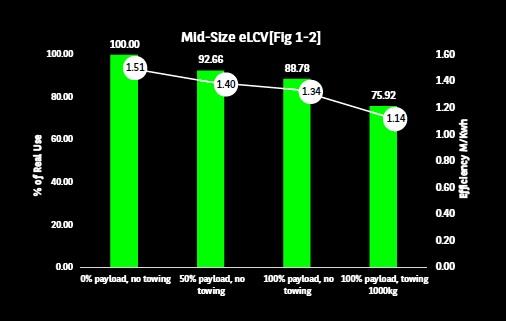'Electric vehicles revealed: Does towing and payload affect range?' (https://is.gd/sopidu) confirmed a focus on the impact of towing in electric light commercial vehicles (eLCV) necessitated calculating the real-world range. Using the official Worldwide Harmonised Light Vehicle Testing Procedure (WLTP) range as a starting point for the impact of towing would not have produced useful results.
According to Arval UK, this is because it is already accepted that the manufacturer WLTP figures do not accurately reflect real-use electric vehicle efficiency data that fleets and individuals achieve in every day driving.
In this testing, the full size eLCV saw a real-use range of 57% of its WLTP figure while the mid-size eLCV recorded a real-use range of 55% WLTP.
The United Test and Assembly Centre (UTAC) carried out testing for Arval at its test centre in Milbrook, Bedfordshire. The full size eLCV was tested under four scenarios: 0% payload and no towing, 50% payload and no towing, 100% payload and no towing and 100%, towing 500kg. A similar test was carried out on a mid-size eLCV, but the fourth scenario saw it tow 1000kg.
Moving from unladen to a half load, the large eLCV experienced an 11.3% drop in range and efficiency. Moving on to a full load, there was a smaller 3% drop in range. Add in towing and the range dropped a further 17%.
Overall, the difference between the real-use range and towing with a full load resulted in a 31.4% drop. In other words, fleets and drivers can expect a range that’s 68.6% of the real-use maximum when towing the same maximum load.

(Image credit: Arval UK)
The initial drop in efficiency for the mid-size eLCV from unladen to 50% load resulted in a 7.3% drop. There was a further 3.9% drop at 100% load and then an additional 12.9% drop when towing with a full load onboard.
The combined drop in range from unladen to fully laden and towing was 24.1%, or a 75.9% range when compared to the real-use maximum when towing the same maximum load.

(Image credit: Arval UK)
Report contributor and Arval UK’s LCV Consultant Simon Cook, said: “For commercial vehicles, which typically tow while also carrying a full load, the research found range was reduced between a quarter and a third over the real-use figure.
“What does this mean in reality? If your fully-charged van range is typically 120 miles unladen, then you're looking at a 83-91 mile maximum while towing. If you're already operating on the basis of a range while at 100% payload and a range of 105 miles, then the impact of towing will be a 14-22 mile decrease.”
Cook added: “Electric vehicles are very good for the act of towing – their smooth and instant power delivery really helps. However, the range and charging infrastructure mean electric vans won’t work for all businesses’ needs at this point in time. Arval’s data empowers fleet managers and corporations to work out which jobs electric vans can do now. It also shows that when upcoming new longer-range electric vans are available, how these could be used by businesses.
“Solving the BEV adoption hurdles in the wider LCV market may need some significant work, but in all but a couple of areas progress is being made,” said Cook.
“Van ranges in the small and medium sectors are improving rapidly. Charging infrastructure is seeing significant investment. There are however still difficulties surrounding larger eLCVs that cover higher mileages.”